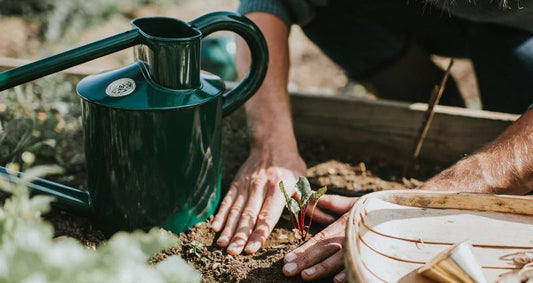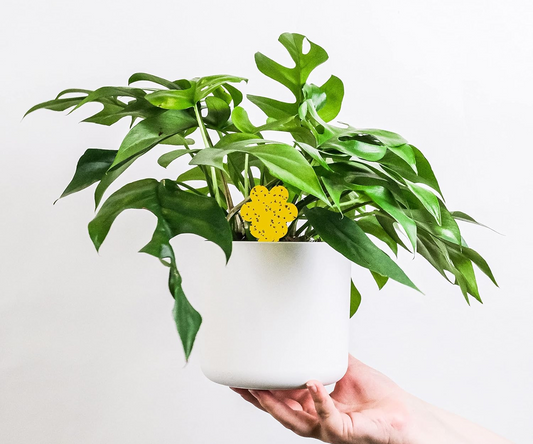Sustee FAQs
How do I take care of SUSTEE?
After long periods of usage SUSTEE might not react as swiftly as it should. This may be due to soil sticking to it. Mix neutral detergent with warm water and place SUSTEE upside down (the window facing downwards) in it and let it soak for about an hour. Whatever is sticking to SUSTEE should come off and dissolve this way.
After cleaning let SUSTEE dry till it shows white. It can be used again after cleaning.
Can SUSTEE be used for any plant?
It can be used for almost all plants that grow in soils with a certain level of moisture retention: from bog moss to gardening culture soil, Akadama soil, black earth, bark, coco peat, peat moss and vermiculite.
SUSTEE is also instrumental in hydroculture, such as hydroponic cultivation and bottom watering, as well as in container vegetable gardening and roof-top open culture, to mention just a few application areas.
Where should it be inserted?
SUSTEE should sense moisture around the plant's roots at the bottom of a pot. So it needs to be placed close to the plant itself, within a 20 cm radius.
Watering frequency varies from one type of plant to another. Does SUSTEE work for different types of plants?
Yes, it does!
There is a beneficial soil moisture range shared by all plants.
It is called "available water capacity", which works as a common denominator for moisture management for all plants, preventing them from root rot and drying up.
SUSTEE helps you to water the right way to maintain this beneficial moisture range.
(Patented product)
SUSTEE's performance, the outcome of collaboration with plant farms, has been greatly appreciated by professional plant growers.Please see About Sustee for more information.
When should I water?
Time for watering your plants has come when the little window on SUSTEE's top has turned white completely.
How much water should I use?
The correct amount of water is equal to a fifth to a quarter of whatever volume your pot holds. Try to water evenly.
I see no color change on SUSTEE after watering. What's wrong?
One of the following may be hindering water supply:
<First-time use>
Not enough water was given. When using SUSTEE for the first time, please water generously after inserting it in the pot until water drips out into the saucer. However, excess water in the saucer must be avoided afterwards.
<SUSTEE is in poor condition>
SUSTEE has a hole at its bottom for soaking up moisture. If it gets clogged with old soil, excess roots of a root-bound plant or dirt with extremely high viscosity, SUSTEE may no longer absorb water. This can be improved by loosening the soil before inserting in the SUSTEE device or trying a new spot for its insertion.
<Water drains too well to be absorbed by SUSTEE>
SUSTEE has a hole at its bottom for soaking up moisture.Water may drain too quickly in extremely grainy earth for SUSTEE to absorb, resulting in no color change. This may be improved by pouring water mindfully over the bottom of the SUSTEE device when watering the plant.
Color indication may work better if SUSTEE is inserted into the pot soil before watering, as the device is constructed in such a way that its core will soak up water through capillary effect and change color. A kind of pump priming effect can be expected.
Please see our operating manual if your SUSTEE was used for less than six months.
It may be time to replace it if your SUSTEE was used for more than six months.
How long does it take SUSTEE to indicate a color change?
It depends on the amount of water given and the water retention level. The periods given below are only rough guides. With some soils it can take up to an hour. Remember to water generously when you use SUSTEE for the first time.
Size S: Approx. 3 minutes
Size M: Approx. 15 minutes
Size L: Approx. 25 minutes
SUSTEE turns whitish at different rates, depending on whether it is in the pot or out of the pot. Is it working properly?
Yes it is. SUSTEE dries up at different rates, depending on where it is located. It turns white quicker when it is stuck in a pot.
How do I know when to replace the core refill?
1. Take the SUSTEE device out and verify the opening at the bottom. If the core refill has decomposed and gone, it is time to replace it with a new one.
2. It should be replaced when the device stops reacting, even though the core refill is not entirely gone.
After use for a long time, the device might react poorly due to soil components or other fine particles deposited onto it.
We recommend core refill replacement if SUSTEE's reaction does not improve even after the measures described in the Operating Manual have been taken.
<Approximate replacement frequencies according to the soil type>
Organic culture soil (for roses or home vegetable gardens): About 6 to 9 months
Inorganic soil (for foliage plants etc.): About 9 to 12 months
Hydroculture: About 1 to 2 years
Bog moss/bark: About 1 to 2 years
Peat moss: About 1 year
We conduct field stress testing in hostile environments to ensure the reliable performance of the product under a variety of conditions.
Please feel free to contact us if you find the product unsatisfactory.
What's the insertion depth of SUSTEE?
Insert Sustee in between▼▲
What size is right for my plant?
Please see the drawing below.
Is it recommended to have SUSTEE show blue all the time?
We do not recommend watering if SUSTEE shows the slightest hint of blue, but to wait until it is completely white. Although one tends to water to much, please wait until SUSTEE has turned white completely.
What do the colors blue and white indicate?
Blue: The soil is adequately hydrated, no additional water required. White: The soil is dry and watering required.
Is it possible to delay the watering e.g. to wait for three days after SUSTEE has changed its color to white before I start watering?
This is no problem. You can take the change of color as an orientation and decide when you find your plants fit for watering.
Will the change of color alter with the seasons?
Yes. During hot summers water in a pot will evaporate much quicker, leading SUSTEE to turn white much quicker than in spring or autumn. In winter however, water will evaporate slower, which will result in SUSTEE staying blue for longer periods than in spring or autumn. With SUSTEE you will see that the appropriate time to water your plants will change with the seasons.
Is SUSTEE affected by water sprayers or rain?
No. SUSTEE registers the amount of water in the soil. If the product gets wet and changes its color to blue, it will turn white again, as soon as the soil is dry.
Is SUSTEE affected by mineral or organic fertilizer or influenced by pesticieds?
If not overused and with low oil content, SUSTEE will not be affected by fertilizers or pesticieds.
-

🌸 Spring is in the Air 🌸
There’s something magical about spring. After the chilly, slower months, the nature all around us suddenly bursts back to life. Longer days, warmer soil, and those first signs of fresh...
🌸 Spring is in the Air 🌸
There’s something magical about spring. After the chilly, slower months, the nature all around us suddenly bursts back to life. Longer days, warmer soil, and those first signs of fresh...
-

How to Get Rid of Fungus Gnats
Got Gnats? If you’ve noticed tiny little flies buzzing around the base of your plant there’s a good chance they're fungus gnats. Fortunately, fungus gnats are not harmful to humans,...
How to Get Rid of Fungus Gnats
Got Gnats? If you’ve noticed tiny little flies buzzing around the base of your plant there’s a good chance they're fungus gnats. Fortunately, fungus gnats are not harmful to humans,...
-

Winter Plant Care Tips
Australia is a big country with a number of different climate zones but, unless you (and your houseplants) are lucky enough to live in the tropics, you will need to...
Winter Plant Care Tips
Australia is a big country with a number of different climate zones but, unless you (and your houseplants) are lucky enough to live in the tropics, you will need to...


